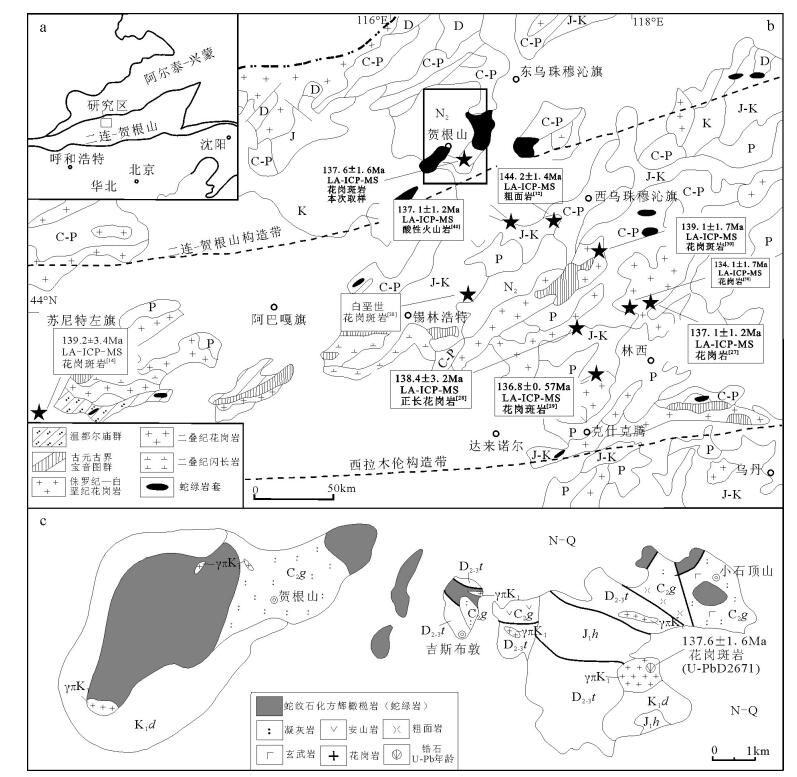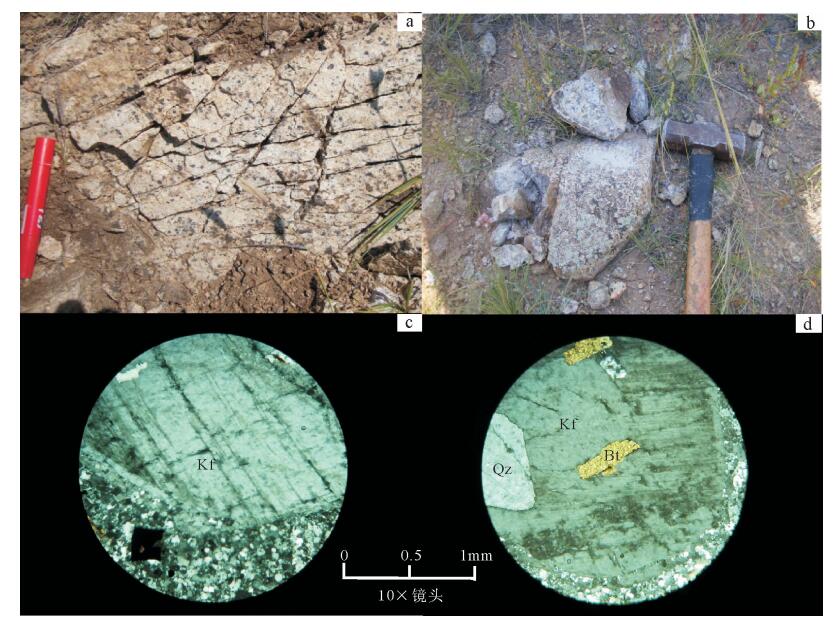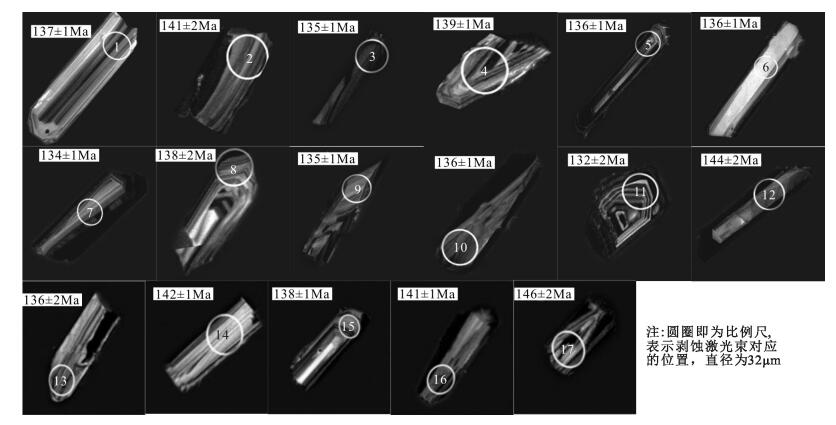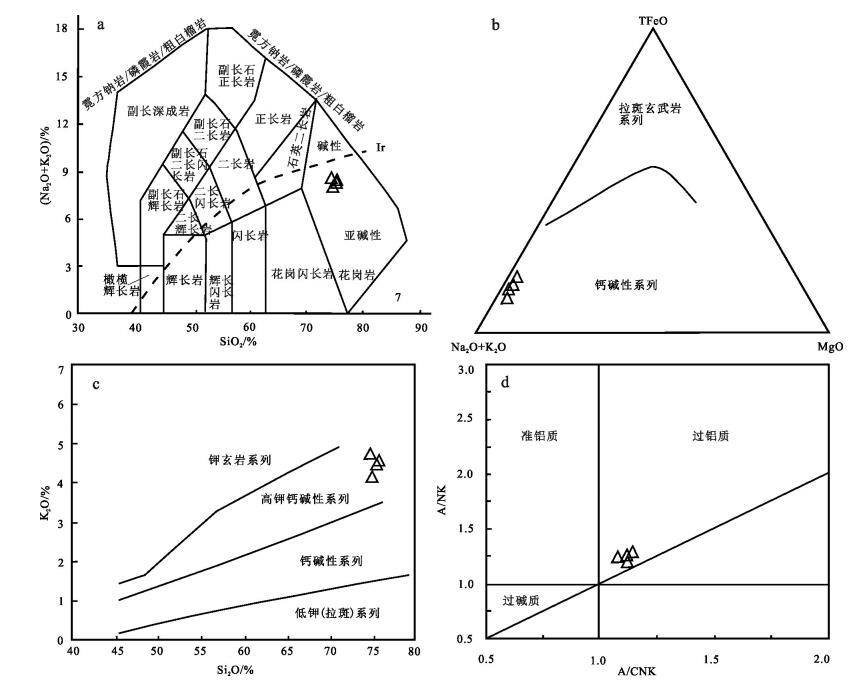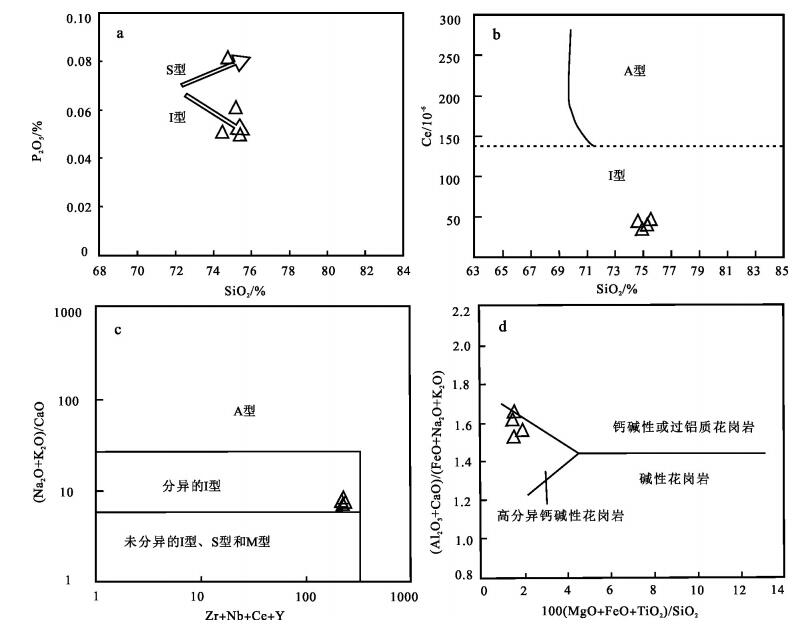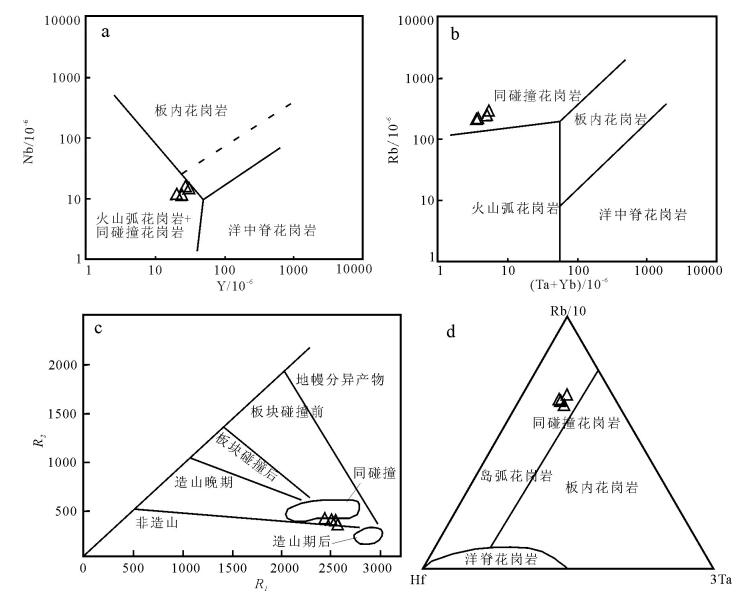Ages, origin and geological implications of Early Cretaceous granite porphyry in Hegen Mountain, Inner Mongolia
-
摘要:
贺根山花岗斑岩位于华北板块和西伯利亚板块结合部位,锆石206Pb/238U年龄加权平均值为137.6±1.6Ma,为早白垩世岩浆活动的产物。地球化学特征表现为主量元素总体富硅,且有较高的分异指数(DI)及碱/铝(NK/A)、Fe2O/FeO值,较低的TFe、Ti、Mg、Ca和P含量;微量元素蛛网图则表现为富集大离子亲石元素Rb、Th、U,弱富集轻稀土元素La,Ce,明显亏损高场强元素Nb、Ba和Sr、Ti。稀土元素配分图表现为相对富集轻稀土元素、亏损重稀土元素,轻、重稀土元素分异较大、重稀土元素曲线较平坦的右倾型特征。综合分析认为,贺根山花岗斑岩属于高分异弱过铝质高钾钙碱性系列的Ⅰ型花岗岩,其源区物质可能为来自高钾、正常水含量的长英质陆壳岩石物质。花岗斑岩成因可能是晚古生代末-中生代初古亚洲洋闭合引起的一系列板块碰撞作用(包括蒙古-鄂霍次克洋闭合),使造山后期地壳逐渐增厚并发生重力垮塌,导致构造环境由挤压转变为伸展,同时受古太平洋板块西向俯冲影响的结果。
Abstract:Zircon U-Pb age of granite-porphyry in Hegen Mountain located in the conjunction of the North China plate and the Siberia plate is 137.6±1.6Ma, suggesting that the rockswere formed by magmatic evolution during Early Cretaceous. The geochemical data indicate that major elements are characterized by enrichment of Si, higher DI and NK/A as well as Fe2O/FeO ratios. The trace element spider diagram indicates that graniteporphyry is relatively rich in Rb, Th, U, slightly enriched in light rare earth elements La, Ce, and depleted in high field strength elements such as Nb, Ba, Sr and Ti, while the distribution model of REE is right oblique, exhibiting relative LREE-enrichment and HREE-depletion, and the HREE curve is flat. These results suggest that the granite porphyry is attributed to high differentiated metaluminous-weakly peraluminous high calc-alkaline series, being typical Ⅰ-type granite. The source materials might have come from crustal felsic rocks with high K and normal water content. The formation of the granite porphyry may be related to the process from the extrusion to extension resulting from the lithosphere thinning after plates collision (including Mongolia-Okhotsk Ocean) with the closure of Paleo-Asian Ocean during the Late Paleozoic to the Early Mesozoic. It was also affected by the westward subduetion of the Paleo-Pacific Ocean.
-
西太平洋地区自中生代起先后经历了古太平洋与现代太平洋2个阶段的动力学体系, 新生代以来的造山运动被黄汲清先生[1]称为“喜马拉雅运动”(Himalaya orogeny)。该造山运动使整个亚洲大陆都受到强烈改造[2]。在新生代, 欧亚板块西缘的特提斯洋闭合隆起为巨大的山脉, 形成了著名的阿尔卑斯-喜马拉雅造山带, 为绵延数千千米的宏伟山脉, 是地球上最新的褶皱山系, 至今它的活动性仍很强烈[3]。同时, 太平洋板块大致自始新世开始持续向西俯冲于欧亚大陆之下, 在亚洲大陆东缘形成一系列的海沟-岛弧带及占全球3/4的边缘海盆地, 明显有别于东太平洋地区(图 1)。亚洲大陆东西两侧在新生代不同构造体制的共同作用下, 从中生代东高西低的地形倒转变为现代西高东低的地貌, 从珠穆朗玛峰到马里亚纳海沟形成了一个高差达20000 m的巨大斜坡[5]。
在大地构造研究中, 角度不整合被认为是认识和确定造山运动、划分造山旋回的重要标志之一, 但并不是所有的角度不整合都代表一次重要的造山运动, 只有在地史发展过程中有重要作用的造山运动形成的区域性角度不整合, 即在一个相当大的区域内普遍存在, 能够识别出的角度不整合, 才有大地构造意义, 才有划分地史阶段和构造旋回的意义[6]。
与中国西部不同, 华南或整个中国东部, 喜马拉雅山期的构造演化主要表现为地壳的升降运动, 伴有大陆裂谷型火山活动, 沉积记录稀少且连续性极差, 多集中于大型陆相含油盆地或山间小盆地内, 因而难以通过地层的对比划分识别连续的区域不整合界面, 已有的对中国东部喜马拉雅造山事件期次、性质的研究也大多基于海域地震、地质观测、变形构造等研究[3, 7-10], 缺少与陆上地层系统之间的对比。相比之下, 在西太平洋其他地区, 地壳主体形成于新生代, 沉积-构造记录齐备, 对其开展研究有助于在更大区域上建立新生代地层格架, 查明其中区域性角度不整合的时代、性质及其代表的造山过程。
自2016年起, 在任纪舜院士主导的国际亚洲大地构造图(ITMAS)框架下, 笔者团队开展了太平洋构造域南段1:250万地质图——大地构造图编图及区域大地构造研究工作, 对华南及邻区的物质组成及构造演化进行系统梳理。本文介绍华南(即中国红河-龙门山断裂以东,青峰-襄樊-广济及郯城-庐江断裂以南的广大区域)及其邻区(包括日本、菲律宾、印度尼西亚及巴布亚新几内亚地区)主要构造单元的新生代地层序列及构造演化特征, 通过对比确定不同构造层及其之间的区域性角度不整合界面, 作为识别新生代构造事件及划分构造运动阶段的依据,并以此探讨西太平洋南段喜马拉雅造山事件的性质及其背景, 为深入理解华南新生代地质-地貌变动提供参考。
1. 地质背景
中国华南及日本、印尼、菲律宾、新几内亚等国家及地区夹持在东侧太平洋板块及西侧印度洋-澳大利亚板块之间(图 1;表 1), 在大地构造单元的组成上, 本区既包含古老克拉通(扬子), 又存在古老的造山系(华南加里东造山系), 并普遍叠加了中生代活化带及造山带, 最后在现代大洋俯冲作用的影响下, 形成复杂的(岛/陆缘)弧-盆-陆缘裂谷系统[11-17]。
表 1 华南邻区新生代大地构造单元划分Table 1. Tectonic units of the adjacent regions of South China一级构造单元 二级构造单元 三级构造单元 Ⅰ 西太平洋弧盆系 Ⅰ-1 日本岛弧 Ⅰ-1-1
Ⅰ-1-2
Ⅰ-1-3
Ⅰ-1-4西南日本外带
西南日本内带
东北日本岛弧
千岛岛弧Ⅰ-2 台湾-菲律宾岛弧 Ⅰ-2-1
Ⅰ-2-2奇美火山弧
菲律宾岛弧Ⅰ-3 巴拉望-三宝颜陆块 Ⅰ-3-1
Ⅰ-3-2巴拉望陆块
三宝颜陆块Ⅰ-4
Ⅰ-5
Ⅰ-6伊里安-新几内亚陆缘增生带
伊豆-小笠原岛弧
哈马黑拉岛弧Ⅱ 东印度尼西亚弧盆系 Ⅱ-1 爪哇-班达岛弧 Ⅱ-I-1
Ⅱ-I-2爪哇岛弧
班达岛弧Ⅱ-2 东苏拉威西造山带 Ⅱ-3 苏拉威西岛弧 Ⅱ-3-1
Ⅱ-3-2西苏拉威西岛弧
北苏拉威西岛弧Ⅱ-4 松巴地块 Ⅲ 澳大利亚陆缘造山带 Ⅲ-1
Ⅲ-2
Ⅲ-3帝汶-布鲁造山带
苏拉地块
新几内亚褶皱带显生宙以来, 围绕超大陆的聚合与裂解, 研究区经历了多旋回的构造演化。整个古生代属于潘吉亚超大陆的汇聚阶段, 经历了加里东、华力西2个亚阶段, 分别对应冈瓦纳及潘吉亚超大陆的形成[2]。早中生代开始, 随着潘吉亚超大陆裂解, 华南大陆, 西南日本的黑濑川、南北上山微陆块,以及澳大利亚周缘的一些微小地体等不断向南漂移, 并逐渐达到现今位置, 这一裂解过程持续至今。同时, 古太平洋及新特提斯洋也分别在欧亚大陆东西两侧形成, 并开始控制研究区地质演化。
研究区中生代以来的构造演化可分为印支期(T-J)、燕山期(J-K)及喜马拉雅期(E-Q)3个亚阶段。其中前两者受控于古太平洋-新特提斯洋体系。从中侏罗世开始, 古太平洋-新特提斯洋板块分别从东、西两侧俯冲于欧亚大陆之下, 形成了环绕欧亚大陆的燕山造山带, 并伴随强烈的岩浆-成矿作用[2]。晚白垩世—古近纪, 上述2个大洋消亡, 太平洋-印度洋扩张形成, 从始新世开始俯冲于欧亚大陆之下。2个大洋的俯冲速度、角度等变化, 控制着新生代整个欧亚大陆的地质演化。此时, 华南及澳大利亚板块均为稳定的大陆地壳, 其构造演化主要表现为陆内盆地沉降变化及整体性抬升或断块作用。相反, 在大陆边缘, 受俯冲作用影响, 形成了复杂的增生型造山带及多岛弧-盆系。根据研究区的基底物质组成(亲缘性)、地壳演化特征及造山类型, 笔者将研究区新生代大地构造单元划分为西太平洋弧盆系、东印度尼西亚弧盆系及澳大利亚陆缘造山系3个Ⅰ级造山带。其中, 前两者的形成受控于大洋板块向大陆的俯冲作用, 后者则受控于澳大利亚板块边缘及与欧亚大陆边缘弧盆系之间复杂的碰撞作用。
在西太平洋弧盆系内, 太平洋/菲律宾板块自北向南沿日本海沟、马里亚纳海沟、琉球海沟、菲律宾海沟及新几内亚海沟俯冲于欧亚板块之下, 形成日本-台湾-菲律宾的近南北向岛弧链, 弧后由日本海、南海、苏禄海、苏拉威西海、马鲁古海峡等一系列边缘海盆地与欧亚大陆分割; 在更南侧, 太平洋板块俯冲于澳大利亚北缘之下, 形成哈马黑拉岛弧及伊里安-新几内亚的增生造山带。根据不同地区的基底物质组成及构造演化特征, 西太平洋弧盆系可进一步细分为日本岛弧、菲律宾-台湾岛弧、巴拉望-三宝颜陆块、伊里安-新几内亚陆缘增生带及哈马黑拉岛弧Ⅱ级构造单元。
在东印度尼西亚弧盆系内, 自始新世开始, 印度洋-澳大利亚板块沿苏门答腊-爪哇-帝汶海沟俯冲于欧亚大陆南缘的巽他大陆之下, 在大陆边缘形成爪哇-班达岛弧、苏拉维西岛弧, 以及从爪哇岛弧中裂离的松巴地块3个主要的Ⅱ级构造单元[11-12]。同时, 由于班达海的扩张及古班达海的西向俯冲, 早期的弧后盆地闭合, 东苏拉维西地体与西苏拉威西岛弧碰撞[18], 在苏拉威西岛的东侧形成东苏拉威西造山带。
此外, 由于印度洋-澳大利亚板块的持续向北俯冲, 新生代, 澳大利亚周缘的弧盆系与欧亚板块边缘的弧盆系发生多阶段、多类型的碰撞, 形成环绕澳大利亚板块的陆缘增生型造山带, 即澳大利亚西缘的帝汶岛-布鲁岛-塞兰岛造山带, 以及澳大利亚北缘伊里安岛-新几内亚中部近东西向的新几内亚褶皱带[19](图 1;表 1), 二者分别以帝汶海沟及新几内亚逆冲断裂带与东印度尼西亚弧盆系及西太平洋弧盆系相隔。整个新生代, 主要的造山作用及沉积-岩浆记录都发生在上述大陆边缘造山带和弧盆系内。
2. 西太平洋弧盆系新生代主要构造单元地层-构造特征
2.1 日本岛弧
现代日本列岛是一个具有典型沟(日本海沟-马里亚纳海沟)-弧-盆(日本海)结构的岛弧, 夹持在欧亚、菲律宾海、太平洋和北美板块之间[20-22]。菲律宾板块沿南开海沟俯冲于西南日本岛弧之下[23]。西南日本岛弧以中央构造线(MTL)为界, 可进一步分为内带及外带, 内带基底由大陆地壳及古生代—中生代增生杂岩-变质岩组成, 外带主体是晚中生代以来的增生杂岩, 但也夹有古生代大陆残片(黑濑川带)(图 2)。
白垩纪末期—古近纪早期,当古太平洋板块板块消亡于欧亚大陆之下后, 受洋脊俯冲的影响, 日本列岛的白垩纪高压变质-岩浆作用停止[24-28], 西南日本外带的白垩纪高压变质岩迅速抬升剥蚀并发生退变质作用[29-31]。整个西南日本(事实上也包括东北日本)古新世均处于剥蚀阶段, 缺少连续的沉积记录。直至始新世早—中期, 沿Aki构造线(ATL)在西南日本外带古海沟前形成南四万十俯冲增生杂岩(图 2)。在西南日本内带则零星分布含煤的湖相-河流相地层, 以紫红色砂砾岩、泥岩为主夹较多的陆相火山岩, 向上变为浅海-滨海沉积, 底部有底砾岩层, 高角度不整合于下部褶皱变形的白垩纪或前白垩纪地层之上(图 3)。
渐新世开始, 西南日本整体仍与欧亚大陆毗邻。此时, 欧亚大陆-菲律宾海板块-太平洋板块的三联点应位于九州地区以南或琉球地区[33-34]。渐新世中期, 随着太平洋板块的持续俯冲, 古伊豆小笠原岛弧后发生裂解形成了菲律宾板块西侧的四国海盆(Shikoku Basin)[35], 这使古海沟及增生楔向大洋方向后撤, 位于弧后位置的日本海及千岛盆地开始扩张[36], 日本列岛从此时起逐渐与欧亚大陆分离, 经历了明显的隆升。因而在西南日本内带广泛缺失渐新世晚期—中新世初期沉积。同时, 西南日本外带九州—四国地区的增生楔也向洋后撤, 始新世的南四万十增生杂岩逐渐隆升变为浅海复理石沉积。
中新世初期西南日本的高千穗运动导致弧前南四万十增生杂岩的强烈褶皱, 其上覆盖后碰撞的早中新世浅海砂泥岩组合, 含大量四万十增生杂岩碎屑, 其底部发育底砾岩, 二者的界面在Aquitanian与Burdigalian之间[37], 同时, 伴随着日本海快速裂解(20~15 Ma), 西南日本内带爆发大规模的浅海-陆相火山喷发, 即中新世的“绿色凝灰岩”事件, 岩性以玄武岩、安山质-英安质凝灰岩、砂砾岩、泥岩为主, 在最晚期有少量碱性玄武岩[23]。这套地层角度不整合于下部的古近纪沉积地层或超覆于白垩纪花岗岩之上。在隐岐岛(Oki Island)上, 中—上中新统郡组火山岩角度不整合于褶皱变形的渐新统—下中新统时张山组之上, 二者的界面也在Aquitanian与Burdigalian之间[38], 与外带一致。
至中中新世(约15 Ma), 年轻的、热的四国海盆洋壳开始俯冲于西南日本之下, 同时古伊豆-小笠原岛弧与本州岛弧发生碰撞[23, 34, 39-40],在二者共同作用下, 西南日本外带, 早中新世浅海地层发生NE—SW向褶皱及逆冲断层, 强烈隆升, 并伴随有广泛的花岗质岩浆活动, 侵入于早期的俯冲增生杂岩中, 其时代集中于15~10 Ma。在纪伊半岛及四国地区, 上中新统—上新统/下上新世统宫崎群(Miyazaki Group)浅海砂泥岩角度不整合于下中新统浅海地层之上。同时, 在西南日本内带, 受碰撞事件的影响, 日本海的扩张也于此时(约15 Ma)迅速停止。靠近日本海一侧陆架上的滨浅海地层经历弱的NEE—SW向褶皱变形,以及抬升、逆冲推覆作用, 地壳大规模缩短, 变形时代为5~8 Ma[41], 导致西南日本内带普遍缺失晚中新世—早上新世期沉积。
上新世中晚期, 随着大洋俯冲速率的变化, 整个日本列岛经历了又一次挤压造山事件[42], 发生了明显的地壳缩短, 并发育大量逆冲断层。第四系或晚上新世以来的地层均与下部微角度不整合接触。这一角度不整合在陆上表现并不清楚, 但在海沟附近, 第四纪的浅海碎屑岩却高角度不整合于下部的增生杂岩之上[43]。
第四纪以来, 岛内为广泛分布的陆相火山岩及河流-滨海相粗碎屑沉积, 与下部地层角度不整合接触, 在弧前有埃达克岩存在, 而弧后以碱性玄武岩、安山岩为主。
2.2 菲律宾活动带
菲律宾群岛位于欧亚大陆的边缘, 是由岛弧及微陆块拼贴而成的复杂岛弧[44-45], 发育独特的双俯冲带。大致以马尼拉海沟-内格罗斯海沟-苏禄海沟-哥打巴托海沟为界线, 分为两部分(图 4), 西侧为巴拉望-三宝颜微陆块, 包括巴拉望、西民都洛、北西班乃岛及朗布隆群岛, 是受南海扩张形成的裂离于华南的微陆块[46-49]; 东侧为近S—N向的菲律宾活动带, 也称菲律宾岛弧, 为一复杂的岛弧。前者无地震与火山活动, 后者地震及火山作用强烈[44, 50-51]。
![]() 图 4 菲律宾地质图及大地构造简图(A, 据参考文献①修改)及大地构造简图(B)Figure 4. Geological map(A)and schematic tectonic map(B)of the Philippines
图 4 菲律宾地质图及大地构造简图(A, 据参考文献①修改)及大地构造简图(B)Figure 4. Geological map(A)and schematic tectonic map(B)of the Philippines菲律宾活动带的基底由蛇绿岩及晚中生代浅变质岩组成[52-53]。这些蛇绿岩散布整个列岛, 多形成于岛弧及弧后环境, 且具有自西向东年轻的趋势[45], 可能代表了初始的菲律宾海板残块[51, 53-57], 或者是在岛弧及弧后环境下多期次裂解、扩张的产物[58], 不同学者对菲律宾活动带早期的构造重建存在较大的争议[11-12]。以菲律宾活动带中部莱特岛、宿务岛及邦多克半岛的新生代地层为代表, 整个新生界多由岛弧火山岩及浅海-陆相碎屑岩组成, 存在4个主要的区域性角度不整合(图 5)。
第1个不整合发生于古新世, 古新统在整个菲律宾列岛基本缺失, 仅在海域钻孔内有所发现[53], 这点与巴拉望-三宝颜陆块一致[59]。始新统与前新生代基底之间以角度不整合或断层接触, 岩性以陆棚-深水复理石沉积为主, 常含有中性火山岩。在宿务岛和莱特岛上, 始新统台地相含货币虫灰岩强烈褶皱, 高角度不整合于下部蛇绿岩及海相地层之上(图 5)。在靠近太平洋一侧的邦多克半岛, 多为岛弧环境下的中基性火山岩和闪长岩, 说明此时岩浆前锋并未到达菲律宾西部。
第2个不整合发生于渐新世早期或始新世末期—渐新世早期, 在整个列岛上均极普遍。渐新世早期的地层不同程度缺失, 始新统强烈褶皱, 并伴随中酸性岩的侵入。此界面之上, 渐新世晚期—中新世早期, 菲律宾活动带以滨浅海碎屑-灰岩沉积为主, 并夹有海相煤层。
第3个不整合发生于中新世中期。渐新世开始南海不断扩张, 导致巴拉望-三宝颜陆块从中新世开始向东逐渐与菲律宾活动带碰撞。在巴拉望-三宝颜陆块东缘朗布隆群岛、西民都洛及北西班乃岛一带, 广泛发育中新世的西向逆冲推覆构造和区域变质岩, 一系列晚白垩世—始新世蛇绿岩逆冲推覆于晚渐新世—中中新世地层之上, 标示出了陆块与菲律宾活动带之间古缝合线的位置[46, 60]。此缝合线向南延伸至三宝颜北部辛当岸(Sindangan)—哥打巴托(Cotabato)—苏丹库达拉(Daguma)一线, 碰撞的时代在12~15 Ma之间[53, 59-61]。
巴拉望-三宝颜陆块与菲律宾活动带的碰撞导致整个菲律宾活动带及巴拉望-三宝颜地块隆升, 中中新世地层存在不同程度的缺失, 且自西向东, 地层缺失的时代逐渐变新, 反映了自西向东的挤压过程。根据地震及地质资料, 此次事件也使弧前盆地渐新世—早中新世地层发育宽缓褶皱[62]。
第4个不整合位于中新世末期—上新世早期, 在西菲律宾的莱特岛和东菲律宾的宿务岛上, 晚上新世以来的浅海-河流相灰岩-碎屑岩地层角度不整合于下部中新世地层之上, 底部有底砾岩(图 5)。与前上新世的地层相比, 晚上新世以来的地层多无明显的褶皱变形。此次不整合的时间与菲律宾断裂的左旋平移及广泛的岛弧火山岩活动一致, 一般认为是受菲律宾海板块斜向俯冲及菲律宾-台湾岛弧与欧亚大陆碰撞的影响(小于5 Ma)[63], 因而自东向西, 不整合界面发生逐渐变新的趋势(图 5)。
3. (东)印度尼西亚弧盆系
东印度尼西亚弧盆系位于欧亚大陆的最南缘, 夹持在太平洋板块与印度洋-澳大利亚板块之间, 也是太平洋构造域和特提斯构造域的结合部位[64-66]。其基底既包括古老的大陆地壳, 又包含新生代以来的岛弧-大洋地壳, 还包含从澳大利亚裂离而来的一系列微陆块[11-12, 67]。从海域地形特征看(图 1), 望加锡海峡—苏拉威西海一线以西, 即威尔士线以西, 水深较浅, 与东海地区类似, 多为减薄的大陆地壳基底; 而以东直至帝汶海沟, 大洋水深明显加剧, 具有典型的洋壳基底, 包含爪哇海、苏拉威西海、班达海等一系列深海盆地, 这些盆地的形成均与太平洋、印度洋的持续俯冲作用有关[68]。从晚中生代开始, 东印度尼西亚地区发育持续的俯冲作用, 一直持续至今。由俯冲引起的弧后盆地伸展, 弧-陆碰撞、弧-弧碰撞等过程塑造了该区复杂的地质及地貌。
3.1 爪哇岛弧
现今的爪哇岛弧位于欧亚大陆最南缘, 新生代以来一直受印度洋板块的俯冲, 与其南侧爪哇海沟-弧前盆地(安达曼海)、北侧的爪哇海盆一起构成典型的沟-弧-盆体系(图 1)。
爪哇岛弧的前新生代基底由早白垩世晚期(阿尔必阶)变质岩及其上晚白垩世构造混杂岩构成[68-73](图 6)。根据新生代的岩石组合和构造特征, Java岛一般分为4个带, 自南向北分别为南部山带、中部火山岩带、北部Kendeng带及北部的Rembang带(图 6)[74-75]。中部火山岩带主要由晚上新世以来的火山岩组成, 角度不整合于其他地层之上(图 6)。南部山带主要由古近纪—中新世岛弧火山岩及弧前复理石沉积组成, 北部Kendeng带和Rembang带与Java海一起, 均属于弧后盆地。
![]() 图 6 爪哇地区地质简图(据参考文献①修改)Figure 6. Geological map of Java Island
图 6 爪哇地区地质简图(据参考文献①修改)Figure 6. Geological map of Java Island白垩纪末期—古近纪, 爪哇岛乃至整个巽他陆架大部分地区均为陆地, 普遍缺少古近纪—早始新世乃至中始新世的沉积记录[75-77]。根据钻孔资料, 在爪哇海内古新统—下始新统同样缺失[78]。直到始新世开始, 印度洋板块开始俯冲于爪哇-马来西亚之下, 导致爪哇海等弧后盆地的伸展[68]。此时, 在爪哇岛上, 南部山带中始新统由陆相复成分砾岩、岛弧型火山岩、浅海-陆棚的石英砂岩、含砾砂岩、砾岩及复理石沉积组成[76-77], 角度不整合于下部强烈褶皱变形的晚白垩世混杂岩之上; 而在弧后地区, 始新统则为浅海-陆相粗碎屑岩。上述始新统底部均为底砾岩。在爪哇海内, 含煤的中晚始新世滨浅海碎屑岩, 包括石英砂岩、砾岩、页岩组合同样角度不整合于下部褶皱基底之上[78]。
始新世末期—渐新世早期, 该区经历了明显的构造变动, 导致始新统褶皱并发生明显的变形, 在白垩纪基底出露地区尤为明显(图 6)。古近纪地层与白垩纪增生杂岩构成褶皱的核部, 伴生中酸性侵入岩及火山岩, 同时始新世末期—早渐新世海相地层在陆地及海域内均有缺失。
渐新世晚期—中新世早期, 爪哇岛南侧为弧前复理石沉积, 北侧为陆棚-浅海的泥灰岩和灰岩, 该地层向上逐渐变为碎屑岩沉积。晚渐新世—中新世的火山岩常集中在岛弧南侧, 以钙碱性铁镁质为主, 常伴有斑岩型铜-金矿化, 指示了岩浆前锋及古岛弧的位置, 同时弧前伴生有礁灰岩及火山碎屑岩。而在弧后位置, 早—中中新世以泥灰岩、泥岩、灰岩为主, 向上变为凝灰质砂岩、钙质砂岩、石英砂岩等组合。
中新世末期(大约在Messinian阶)—上新世早期, 南部山带隆升成陆, 开始剥蚀; 同时, 南侧Kendeng带、Rembang带新近系强烈褶皱(图 7)。弧后的爪哇海也经历了明显的构造反转[68]。
上新世后期开始, 整个Java岛被分布于中央部位广泛的火山活动控制, 南部山区为剥蚀区, 北部弧后位置由浅海相的礁灰岩、火山碎屑岩组成, 物源主要来自南部山区, 角度不整合于下部中新世褶皱地层之上(图 7)。中部火山岩带以钙碱性玄武岩-安山岩为主; 弧后位置则有少量中酸性碱性岩, 如白榴石响岩等, 二者都以中心式喷发为主, 火山活动持续至今[79-80]。
3.2 东苏拉威西造山带及西苏拉威西岛弧
苏拉威西岛位于巽他陆架的边缘, 是欧亚板块与印度洋-澳大利亚板块、太平洋板块三者的接合部位[72], 也是整个东南亚地区构造演化最复杂的地区。整个苏拉威西岛由不同的微陆块及岛弧拼贴而成, 为变形的K字型。大致沿其中部可分为西苏拉威西岛弧和东侧的造山带。在西苏拉威西地区, 将北部近EW向延伸的岛弧称为北臂(north arm)或北苏拉威西, 南侧称为南臂(south arm)或南苏拉威西(图 8)。从南臂中新生代的花岗岩中出现的大量太古宙—元古宙捕获锆石,以及新生代变质杂岩中古生代变花岗岩看, 其基底应仍为大陆地壳性质[81-84], 属于巽他大陆边缘弧的一部分; 北臂的地壳则为古近纪以来的大洋基底。在苏拉威西岛东侧为苏拉地块或称苏拉地台, 包括邦盖岛、苏拉群岛及苏拉威西的卢武克地区(图 8), 是在新生代从澳大利亚大陆上分离的一个微陆块, 并在上新世中期与东苏拉威西碰撞拼贴[70-71, 83-85]。
3.2.1 东苏拉威西造山带
东苏拉威西的基底主要由早白垩世变质杂岩组成[86-88], 这些变质基底可能于始新世伴随着弧后(即望加锡海峡)的伸展从巽他陆架边缘裂解。这一弧后伸展事件也形成了东苏拉威西蛇绿岩(ESO)。在ESO中, 玄武岩兼具有MORB-SSZ的特征, 其时代及地球化学特征与苏拉威西海一致[89-90]。
渐新世—中新世初期上述弧后盆地闭合, ESO与前述基底碰撞并仰冲于东苏拉维西基底地层之上。在东苏拉威西的西侧, 不整合在蛇绿岩及基底地层上的一套构造混杂岩称为Peleru混杂岩, 其基质有2种:一种为红色复理石, 弱变形, 其中夹的岩块以侏罗纪浅海碎屑岩、古生代岩块及白垩纪灰岩、放射虫硅质岩为主, 代表了早期俯冲形成的增生楔; 另一种基质主要为叶蛇纹石和滑石, 且含针状蓝闪石碎屑, 其中的岩块以蛇绿岩透镜体及结晶较好的粗粒蓝片岩、角闪岩为主, 其基质白云母K-Ar年龄为26~33 Ma, 代表蛇绿岩仰冲就位的时代[91]。这次碰撞的影响一直持续到中新世中晚期, 随后东苏拉威西快速隆升, 沉积陆相磨拉石建造, 称为Banka组, 角度不整合于早期地质体之上(图 9)。
3.2.2 西苏拉威西岛弧
在望加锡海峡张开前, 西苏拉威西岛弧与加里曼丹岛相连, 二者的基底均为白垩纪俯冲增生杂岩和变质岩, 包括Latimojong(K2)和Bantimala(K2)2个杂岩体[70, 82-83]。西苏拉威西古近系的特征与爪哇及南东加里曼丹地区相似。在西苏拉威西, 古新统—下始新统缺失, 始新统—渐新统为一套被动大陆边缘环境的陆相-浅海碎屑岩, 整个始新统为一海进序列, 在南臂始新统底部含煤层。这些特征与前述爪哇岛和爪哇海内沉积极相似, 因此在始新世二者都属于巽他大陆边缘沉积系统[68, 92]。同期的火山岩以双峰式火山岩和弧后环境下的玄武岩-安山岩为主, 北苏拉威西下始新统Tinombo组内玄武岩的K-Ar年龄为52.6~42.5 Ma[93-94]。
渐新世, 受东苏拉威地块碰撞和仰冲的影响, 西苏拉威西地区始新统—渐新统常形成紧闭的同斜褶皱并发生浅变质[84], 渐新世末期—早中新世地层普遍缺失。这一碰撞造山事件可能伴随着部分起源于澳大利亚周缘的微陆块拼贴至西苏拉威西岛弧中, 并在蛇绿岩就位后发生区域性变质。
此后, 南臂属于大陆边缘弧的一部分, 形成陆缘浅海碎屑岩-灰岩沉积, 同时伴生有钾质及超钾质火山岩, 表明当时地壳处于明显的加厚状态[93-95]。而同时期, 北臂发育正常的钙碱性火山岩, 这种差异显然受地壳性质不同控制, 北臂在中新世可能与现今一样, 为大洋岛弧, 而南臂为陆缘弧。中新世晚期开始, 受俯冲板块断离和地壳伸展的影响, 全区均发育中酸性钙碱性火山岩和钙碱性花岗岩类, 持续到上新世早期。
中上新世, 苏拉地块与东苏拉威西造山带碰撞, 导致整个苏拉威西岛快速隆升及褶皱、逆冲推覆构造, 向西一直延伸至望加锡海峡内, 使其中发育明显的薄皮褶皱和反转构造[96-98]。在此背景下, 上新世全区均发育一套陆相的磨拉石建造, 称为Celebes Molasse, 角度不整合覆盖于其他地层之上[94]。同时, 早期的变质岩快速隆升, 形成变质核杂岩[88]。
4. 华南
整个新生代, 华南地区基本继承了晚白垩世以来的古地理格局, 但沉积盆地范围大幅度缩小。盆地分为2类:一类为新形成的断陷盆地和山间盆地, 但此类盆地一般规模较小, 地层发育不全; 另一类为继承于晚白垩世盆地之上的, 如云南楚雄、洞庭、苏北盆地等, 沉积厚度巨大且连续, 尤其是苏北盆地, 晚白垩世以来的沉积记录齐全(图 10)。
在靠近太平洋一侧的下扬子地区, 新生代沉积集中于苏北盆地及其周缘及长江流域。苏北盆地新生代最老的地层为泰州组, 出露十分局限, 在许多地方缺失。泰州组的时代一直存在争议。根据岩性, 泰州组可分上、下2段, 上段孢粉组合可与邻区早古新世组合对比; 下段的孢粉组合则具晚白垩世特点, 与晚白垩世赤山组或浦口组的组合相似[99]。同时, 泰州组中下部地层内玄武岩碎屑的Ar-Ar年龄约为83 Ma[100]。暗示泰州组的时代应从晚白垩世晚期延续到古新世早期。泰州组与下部赤山组之间的角度不整合所代表的构造运动, 在江苏称为仪征运动, 其时代与上扬子的四川运动一致[101]。在南京北侧林场地区, 可以看到始新世近水平的地层角度不整合于高角度倾斜的晚白垩世浦口组红层之上[102], 说明此次运动与上扬子地区一样, 同样导致白垩纪地层发生较强的褶皱与变形。
苏北盆地古新统包括阜宁组、戴南组及三垛组, 均为湖相地层, 与泰州组基本假整合接触, 盆地边缘有时为微角度不整合, 其内部存在多个假整合界面。阜宁组时期发生过多次短暂的海侵事件, 暗示此时中国东部已经形成了类似现代地貌的边缘海盆地, 并与海域部分联通。在这些湖相地层中, 多夹有裂谷型玄武岩夹层, 其Ar-Ar年龄变化于58~32 Ma之间[100]。
渐新世本区发生了一次较强的构造事件, 苏北地区称为三垛运动, 这次运动使盆地构造沉降停止, 盆地断陷发育期结束, 经历了约18 Ma的沉积间断, 地层遭受抬升剥蚀, 上始新统和渐新统缺失[103], 但地层未发生强烈褶皱与变形。此次构造事件一直影响到上扬子地区, 导致区域上明显的褶皱变形。在宜宾直—雅安一带, 白垩系—侏罗系及古新统构成了明显的NE向复式背斜构造, 其上被新近系角度不整合覆盖[104]。在康滇地区, 中新世小龙潭组与下部始新世路南组角度不整合接触; 在汉南地区, 中新世掇石刀组则角度不整合于下部始新世牌楼组之上。同时, 华南周边的边缘海盆地也普遍出现由裂陷向坳陷转换的构造反转过程及角度不整合事件[105-106]。
此后, 整个扬子地区新近纪的沉积面貌与古近纪大为不同, 沉积面积急剧减少, 许多盆地结束沉积转化为剥蚀区, 直到中新世末期重新接受沉积形成河沼相、河湖相、山麓及河流相地层。下扬子地区的新近纪地层零星分布于盆地周边或长江流域, 产状大多较平缓, 与下部古新系或前新生界呈角度不整合。在南京及周边中新统下部为洞玄观组或六合组, 其岩性为灰黄色-棕黄色砂砾岩、粉砂岩,即岩屑砂岩、粉砂质泥岩, 含哺乳动物及植物化石, 与下伏地层呈角度不整合接触。其上为雨花台组河流相沉积, 盛产著名的南京雨花石, 二者之间为假整合接触[102]。
上新世末期, 可能受吕宋岛弧与台湾的碰撞影响, 下扬子地区发生明显的升降运动, 使江淮地区相对沉降, 其他地区相对上升, 尤以大别和皖南两大山区上升更强烈[107], 大部分地区结束沉积历史, 更新统与上新统或中新统之间为假整合或微角度不整合。
5. 讨论
从上述主要构造单元新生代的地层分布及组成特征看, 整个新生界存在多个明显的区域性角度不整合及地层缺失, 对应几次重要的构造事件。
5.1 古近纪沉积-构造变动
如前所述, 除华南大陆内部及边缘一些白垩纪以来的继承性盆地外, 从西南日本向南到菲律宾、东印度尼西亚, 古新统乃至下始新统大多缺失, 中上始新统—渐新统广泛高角度不整合于下部基底地层之上(图 11)。事实上, 在更南侧的巴布亚新几内亚、帝汶岛, 更北侧的北海道—萨哈林地区, 古新世地层也大多缺失。与地层缺失同时发生的构造事件包括:①高压变质事件, 如四万十变质岩、日高带变质岩、大南澳杂岩[29-30, 35, 121]; ②火山-岩浆活动的停滞; ③地层褶皱变形等。在中国海域, 与其相当的不整合界面, 在东海称为雁荡运动, 在南海北部称为神狐运动[122-123]。在菲律宾巴拉望地区, 晚白垩世浅变质岩被未变质及变形的约87 Ma花岗岩(Daroctan Granite)侵入[124-125], 其上角度不整合覆盖始新世台地相灰岩, 反映了同时段的造山事件。
![]() 图 11 华南及邻区新生代地层柱状简图(数字①②分别代表早、晚喜马拉雅运动界面,蓝色点代表燕山运动界面,西南日本部分数据来源同图 3)Figure 11. Schematic Cenozoic stratigraphic columns of South China and adjacent regions
图 11 华南及邻区新生代地层柱状简图(数字①②分别代表早、晚喜马拉雅运动界面,蓝色点代表燕山运动界面,西南日本部分数据来源同图 3)Figure 11. Schematic Cenozoic stratigraphic columns of South China and adjacent regions根据大地构造重建, 在白垩纪晚期, 新生的太平洋板块推动古太平洋板块向北快速运动, 直到约80 Ma达到最大运动速率[9, 14, 96]。此时, 西南日本外侧的四万十变质岩、大南澳片岩的双变质带大致勾画出了当时古海沟所在位置。持续的俯冲形成了上述地区的高压变质岩, 向大陆一侧岩浆前锋从华南沿海、西南日本内带向南延伸至巴拉望地区。当古近纪开始时, 古太平洋-太平洋板块的洋脊沉没于欧亚大陆之下时, 此次造山事件迅速停滞, 四万十变质岩快速隆升[31]。
同一时刻, 伴随印度板块与欧亚板块的碰撞, 爪哇—苏门答腊地区在古近纪也处于挤压应力状态, 导致早白垩世—晚白垩世不同类型的变质岩、花岗岩及大洋OPS组合发生构造混杂, 形成了爪哇岛及苏拉威西地区的变质基底, 始新世的古生物组合与下部白垩纪有明显的差别, 形成于新的大洋环境[94]。
从构造期次看, 晚白垩世末期发生的此次挤压造山事件应相当于燕山运动的第三幕或弱挤压变形期[10, 126], 代表了燕山期或古太平洋构造域的结束。此次事件后, 古太平洋-新特提斯洋体系消亡, 从始新世开始, 新的太平洋-印度洋重新俯冲于欧亚大陆之下, 形成了西南日本外侧的南四万十带增生杂岩和东印度尼西亚弧盆系内普遍的弧火山岩, 整个西太平洋地区进入了喜马拉雅造山旋回。
5.2 西太平洋南段喜马拉雅运动期次及其性质
西太平洋南段始新世以来的地层可大致划分为3个构造层(图 11)。
第1个构造层为始新统或始新统—下渐新统(E2/E2—E31)。此时西南日本、巴拉望、西苏拉威西及爪哇地区均沉积含煤陆相-滨浅海碎屑岩地层, 自下而上为海进序列, 这些地区大致勾画出了当时欧亚大陆边缘的轮廓。根据火山岩地球化学特征, 应为一个安第斯型的活动大陆边缘弧[11, 93]; 其外侧为苏拉威西北臂、菲律宾等岛弧, 沉积岛弧火山岩及浅海-半深海细碎屑岩、生物灰岩夹硅质岩;海沟处为俯冲增生杂岩组合,以南四万十增生杂岩为代表。大陆内侧为湖湘沉积, 伴有裂谷型火山岩。
第2个构造层为中新统或上渐新统—中新统(N1/E3—N1), 此时西南日本内侧沉积巨厚的中酸性浅陆相-海相火山-碎屑地层, 大陆内部以河流相沉积为主; 而在其他地区均为浅海细碎屑岩、浊积岩地层, 夹海相中基性火山岩、灰岩。
第3个构造层为上新统以上(N2—Q), 研究区转为滨浅海-陆相地层, 底部普遍发育底砾岩, 伴有岛弧火山岩及弧后碱性火山岩, 大陆内部则处于剥蚀状态。
上述3个构造层之间为2个穿时的区域性角度不整合, 代表了2次大的造山事件, 分别发生在渐新世—中新世初期(E3—N11, 33~20 Ma)和上新世(5.3~2.6 Ma), 分别对应于早喜马拉雅运动及晚喜马拉雅运动, 与贾承造等[3]提出的中喜马拉雅运动和晚喜马拉雅运动对应, 或与李廷栋等[10]提出的喜马拉雅运动Ⅰ、Ⅱ幕相当。
根据大洋古地磁研究[14, 127-128], 2次造山事件恰好对应于印度洋板块及太平洋板块俯冲速率开始降低及洋-陆之间汇聚速率的增加。早喜马拉雅造山时期, 在日本四国—九州地区, 扩张的四国海盆导致古伊豆-小笠原岛弧向北运移, 并与西南日本斜向碰撞, 西南日本产生了沉积-构造变化, 在日本称为高千穗运动[24, 34]; 往南, 菲律宾岛弧与台湾中央山脉碰撞, 形成玉里-大南澳缝合带[96]; 在更南侧的澳大利亚北缘, 澳大利亚被动大陆边缘与其北侧的菲律宾岛弧-哈拉马黑-美拉尼西岛弧的碰撞也发生于渐新世, 形成伊里安-新几内亚陆缘增生带及其内侧的变质岩[129-130]。
晚喜马拉雅造山时期, 起源于澳大利亚板块的苏拉地块与苏拉威西岛弧碰撞, 吕宋岛弧也与台湾发生碰撞[94-96, 131], 同时, 在澳大利亚陆缘造山带内帝汶岛上, 巽他陆架边缘的岛弧地体于此时仰冲于澳大利亚板块边缘台地-陆棚相沉积上, 使其中的新近系火山-沉积地层呈高角度紧闭褶皱, 并被上部上新世的泥灰岩及凝灰岩角度不整合覆盖[132-134], 且伴随强烈的变质及变形, 变质年龄在上新世早期(约5 Ma)与台湾地区基本一致[94]。而在该造山带北段, 即新几内亚褶皱带内, 中新世末期受北侧弧-陆碰撞的影响, 白垩系—新近系稳定的台地相沉积快速褶皱变形、隆升成近东西向的高大山脉, 同时在山前形成一套类磨拉石构造和变质杂岩, 角度不整合于下部褶皱地层之上[135-136]。这套地层在底部往往为浅海沉积及砾岩, 向上变为陆相磨拉石建造, 并含有大量火山碎屑岩。这2个造山事件发生的时间与吕宋岛弧-台湾岛的碰撞时限基本一致。
可见, 在不同构造域内, 新生代2次主要造山事件总是伴随岛弧或微陆块向欧亚板块边缘的碰撞拼贴, 这表明早、晚喜马拉雅造山事件并不是2个大陆之间大洋闭合后的碰撞造山, 而是发育于大陆边部的增生造山过程, 这一过程至今仍在进行中。
除上述2次主要构造事件外, 在中—晚中新世之间(15~10 Ma), 还存在一个较普遍的假整合或角度不整合, 代表了区域上另一次较强的构造事件(图 11)。尤其在太平洋一侧, 此次构造事件伴随有花岗质岩浆活动、变质岩及地层的褶皱变形。任纪舜等[64]将其视为中喜马拉雅运动的构造界面。然而在印度洋一侧爪哇及苏拉威西地区, 中新统为连续的斜坡-台地相沉积, 仅存在由升降运动所引起的假整合界面[94], 岛内新近纪地层的褶皱变形主要发生于上新世中晚期[95]; 在苏北盆地及江汉洞庭盆地内, 中新统基本稳定连续沉积[137]; 在南开海沟附近, 中新世增生杂岩与上部的浅海沉积地层之间的角度不整合也主要发生在上新世/更新世期间[34, 43]。
因此, 考虑到2个构造域之间的对比划分, 中新世中期这一角度不整合界面可视为局部的, 而非区域性的, 其引起的沉积作用变化也是轻微的, 并不能以此划分整个区域重大的构造演化阶段。事实上, 这一角度不整合主要受控于菲律宾海板块与欧亚大陆的相互作用, 影响范围有限。
5.3 始新世及中新世西太平洋南段裂解作用
在2次构造事件之间,在西太平洋地区经历了明显的弧后裂解过程。尽管部分学者认为始新世中期存在一次明显的构造运动, 并将其定义为喜马拉雅运动第一幕或早喜马拉雅运动[3]。但这一结论, 大多是根据中国西部或喜马拉雅地区的研究所得出。对西太平洋地区边缘海盆地(如日本海、东海、南海、苏拉威西海、爪哇海等)的地层及地震研究表明, 古近纪—始新世均属于裂解阶段, 始新统与古新统之间的界面为裂解不整合[42, 44, 68, 109, 138-139], 而非挤压构造形成的角度不整合。
在上述几个大陆外侧的构造单元内, 始新统为连续沉积, 并经历了从陆相到浅海相沉积的转变, 伴生有MORB型火山岩-蛇绿岩和双峰式火山岩; 在爪哇海内, 沉积组合也从陆相含煤地层变为浅海碎屑岩, 构成典型的海进序列[78]; 在日本海-朝鲜半岛西岸, 古新世末期开始, 沉积地层的厚度及沉积速率显著增高, 局部出现海相地层, 同时伴随有A型花岗岩及碱性花岗岩[140], 这些沉积变化都暗示了始新世区域的伸展背景。
在大陆内侧, 华南内陆普遍发育始新世—渐新世碱性-拉斑玄武岩, 三水盆地内, 始新世玄武岩(华涌组)相比白垩纪—古近纪玄武岩发生了显著的亏损与地幔源区的突变[141]。类似地, 西南日本的始新世花岗岩相比古新世花岗岩也亏损Nd同位素[25], 暗示存在伸展背景下软流圈地幔上涌。这一阶段恰与洋-陆之间汇聚速率的快速降低对应, 受太平洋与印度洋板块快速俯冲的控制[14, 127]。此外, 根据古地磁重建, 55 Ma太平洋南部持续裂解, 向北俯冲的太平洋板块推动了伊泽奈绮-太平洋洋中脊俯冲到东亚陆缘之下, 可能引起弧后热流更加强烈的上涌, 导致整个东亚陆缘强烈的伸展构造和地形反转[142]。
沉积古地理和古气候资料显示, 中国东南沿海白垩纪高耸的古华夏山脉至始新世中后期可能已经大部分被剥蚀夷平[143], 主要边缘海都开始出现海相沉积。根据长江流域河流中的碎屑锆石分析, 在渐新世或最晚在渐新世/中新世之交, 长江上游的沉积物就已经到达南京地区(即苏北盆地的西缘)[144], 表明此时贯通东西的长江水系已经建立, 华南东高西低的地貌格局已基本建立[5]。这表明经过始新世的裂解过程, 现代地貌的雏形在渐新世已经产生。
此后, 渐新世的碰撞造山事件, 即早喜马拉雅造山运动可能导致俯冲大洋板块的减速及随之而来的板块后撤, 二者共同作用, 使弧后地区快速扩张。因此在这次碰撞之后, 日本海、南海、四国海盆、苏拉威西海等边缘海盆均快速伸展, 出现深海沉积整个东南亚及东亚地区的边缘海基本都在中新世早—中期最终形成[44, 68]。在前述大陆边缘, 也发生了由海陆过渡向海相沉积相的变化, 暗示古近纪的陆缘弧在此时逐渐与大陆隔离从而转化为岛屿, 形成类似于现今的地理面貌。在大陆内则形成了规模巨大的裂谷型玄武岩带, 从东北直至广东地区均有广泛出露。这是亚洲东缘裂解的第二个重要阶段。
在华南沿海地区, 可观察到中晚中新世裂谷型玄武岩(如浙江嵊县组、福建佛昙组)覆盖于白垩纪花岗岩之上, 表明花岗岩上部超过数千米的地壳在此时已剥蚀完毕。这些玄武岩的火山口及火山机构保存较好, 可见当时的地貌与现代无太大差别, 且此后没有经历强烈的剥蚀。
6. 结论
(1) 西太平洋南段晚白垩世末期的构造运动, 导致区域白垩系与上覆地层之间的不整合接触及古新世地层的缺失。
(2) 始新世以来的地层可划分为3个构造层, 彼此间为2个区域性角度不整合分隔, 这2次构造事件分别发生在渐新世—中新世初期(33~23 Ma)和上新世(5.3~2.6 Ma), 对应早喜马拉雅造山运动及晚喜马拉雅造山运动, 且以前者最强烈。西太平洋地区经历了始新世及中新世2次裂解, 中新世后基本形成了现今的地质-地理面貌。
(3) 在西太平洋南侧, 喜马拉雅造山运动的本质是印度洋-澳大利亚及太平洋向欧亚板块边缘的增生造山过程, 受控于俯冲大洋板块方向与角度的变化。
致谢: 岩石地球化学数据分析和构造环境探讨得到中国地质科学院矿产资源研究所余金杰教授、刘帅杰硕士和南京大学地球科学与工程学院孙俊俊博士的大力指导和热心帮助;审稿专家提出了诸多宝贵而中肯的修改意见,在此一并谨致谢忱。 -
图 6 贺根山花岗斑岩球粒陨石标准化稀土元素配分图(a)和原始地幔标准化微量元素蛛网图(b)[27]
Figure 6. Chondrite-normalized REE patterns(a)and primitive mantle-normalized trace element spider(b) diagrams for Hegen Mountain granite porphyry
表 1 贺根山地区花岗斑岩LA-ICP-MS锆石U-Th-Pb测年数据
Table 1 LA-ICP-MS U-Th-Pb data of the zircons from granite porphyry in Hegen Mountain
测试点号
U.PB.2671含量/10-6 同位素比值 年龄/Ma Pb U 206Pb/238U 1σ 207Pb/235U 1σ 207Pb/206Pb 1σ 208Pb/232Th 1σ 232Th/238U 1σ 206Pb/238U 1σ 207Pb/235U 1σ 207Pb/206Pb 1σ 1 13 532 0.0215 0.0002 0.154 0.006 0.0516 0.0019 0.0074 0.0001 0.738 0.010 137 1 145 5 269 84 2 5 232 0.0221 0.0003 0.161 0.011 0.0525 0.0037 0.0085 0.0003 0.416 0.003 141 2 151 11 307 161 3 8 331 0.0212 0.0002 0.149 0.009 0.0510 0.0029 0.0090 0.0002 0.536 0.006 135 1 141 8 241 131 4 6 246 0.0218 0.0002 0.157 0.010 0.0521 0.0033 0.0076 0.0002 0.540 0.012 139 1 148 10 291 146 5 6 275 0.0213 0.0002 0.151 0.009 0.0515 0.0029 0.0080 0.0001 0.581 0.007 136 1 143 8 264 131 6 8 305 0.0213 0.0002 0.147 0.009 0.0496 0.0029 0.0064 0.0001 1.020 0.009 136 1 139 8 178 136 7 11 527 0.0210 0.0002 0.153 0.005 0.0528 0.0018 0.0071 0.0001 0.436 0.008 134 1 144 5 319 77 8 10 442 0.0217 0.0002 0.153 0.005 0.0512 0.0015 0.0075 0.0001 0.356 0.003 138 2 145 4 251 68 9 8 349 0.0212 0.0002 0.156 0.007 0.0533 0.0022 0.0066 0.0001 0.529 0.007 135 1 147 6 341 95 10 8 367 0.0214 0.0002 0.157 0.006 0.0533 0.0019 0.0072 0.0002 0.356 0.002 136 1 148 5 342 82 11 8 349 0.0207 0.0003 0.280 0.010 0.0975 0.0032 0.0123 0.0004 0.382 0.004 132 2 251 9 1577 61 12 5 224 0.0225 0.0004 0.155 0.010 0.0501 0.0033 0.0106 0.0005 0.251 0.006 144 2 147 10 198 154 13 7 286 0.0223 0.0002 0.151 0.001 0.0492 0.0031 0.0118 0.0004 0.409 0.016 142 1 143 9 159 145 14 7 275 0.0216 0.0002 0.157 0.009 0.0526 0.0029 0.0075 0.0001 0.768 0.005 138 1 148 8 310 127 15 8 319 0.0221 0.0002 0.157 0.007 0.0514 0.0023 0.0092 0.0002 0.549 0.008 141 1 148 7 261 104 16 6 253 0.0213 0.0002 0.159 0.009 0.0541 0.0030 0.0082 0.0003 0.342 0.003 136 2 150 9 374 126 17 6 257 0.0229 0.0003 0.160 0.012 0.0503 0.0037 0.0057 0.0002 0.574 0.004 146 2 151 11 211 171 注:测试单位为天津地质矿产研究所 表 2 贺根山花岗斑岩元素分析结果
Table 2 Element analysis results of Hegen Mountain granite porphyry
元素 样品号 P1-13 P1-16 P1-2 P1-4 SiO2 74.39 73.71 74.66 73.99 TiO2 0.13 0.17 0.18 0.14 Al2O3 13.86 13.95 13.38 13.95 Fe2O3 0.61 0.68 0.45 1.11 FeO 0.77 1 0.7 0.8 MnO 0.04 0.04 0.05 0.05 MgO 0.16 0.24 0.24 0.19 CaO 0.77 0.92 0.48 0.76 Na2O 3.83 3.82 3.82 3.93 K2O 4.43 4.69 4.53 4.13 P2O5 0.06 0.05 0.05 0.08 H2O+ 0.72 0.53 1.18 0.69 H2O- 0.68 0.55 0.91 0.86 CO2 0.06 0.06 0.13 0.06 烧失量 0.71 0.47 1.24 0.57 总计 101.22 100.88 102 101.31 Mg# 20.28 23.8 31.3 18.14 La 21.96 23.47 22.52 17.12 Ce 39.76 44.7 46.03 33.59 Pr 5.1 5.33 5.06 4.24 Nd 18.75 19.22 18.44 15.55 Sm 4.48 4.11 4.17 3.9 Eu 0.46 0.59 0.55 0.44 Gd 4.39 3.74 3.82 3.76 Tb 0.91 0.72 0.68 0.79 Dy 5.22 3.93 3.68 4.7 Ho 0.99 0.74 0.68 0.91 Er 2.9 2.06 1.96 2.64 Tm 0.45 0.32 0.31 0.41 Yb 3.09 2.09 2 2.86 Lu 0.43 0.29 0.29 0.4 Y 30.26 23.87 19.96 26.98 Rb 297.35 231.9 223.25 262.87 Sr 45.9 68.6 61.5 41.1 Ba 147.7 291.4 386.4 162.3 Nb 15.07 11.89 11.92 15.86 Ta 2.12 1.51 1.5 2.09 Zr 143.7 155.4 149.4 152 Hf 6.88 6.81 6.7 7.48 Th 14.95 12.91 11.65 13.55 V 6.2 9.6 7.6 5.9 Cr 7.6 7.6 7.2 8.2 Co 1.8 1.9 1.5 1.2 Ni 3.1 2.1 3.7 2.1 Sc 2.75 2.03 1.99 1.9 U 2.38 2.58 2.77 2.24 LREE 90.51 97.42 96.77 74.84 HREE 18.38 13.89 13.42 16.47 ∑REE 108.89 111.31 110.19 91.31 LREE/HREE 4.92 7.01 7.21 4.54 Eu* 0.32 0.46 0.42 0.35 Ce* 0.92 0.98 1.06 0.97 (La/Yb)N 5.1 8.06 8.08 4.29 (Ce/Yb)N 3.57 5.94 6.39 3.26 注:主量元素含量单位为%, 稀土和微量元素含量单位为10-6 -
白文吉.内蒙古贺根山蛇绿岩型铬铁矿中固体包裹体矿物化学成分研究[J].矿物学报, 1993, 13(3):1-6. http://www.wanfangdata.com.cn/details/detail.do?_type=perio&id=QK000004313366 包志伟, 陈森煌, 张祯堂.内蒙古贺根山地区蛇绿岩稀土元素和Sm-Nd同位素研究[J].地球化学, 1994, 23(4):339-349. doi: 10.3321/j.issn:0379-1726.1994.04.004 Nozaka T, Liu Y. Petrology of the Hegenshan ophiolite and its implication for the Planetary Science tectonic evolution of northern China[J]. Earth and Planetary Science Letters, 2002, 202(1):89-104. doi: 10.1016/S0012-821X(02)00774-4
Miao L C, Fan W M, Liu D Y, et al. Geochronology and geochemistry of the Hegenshan ophiolitic complex:Implications for late-stage tectonic evolution of the Inner Mongolia-Daxinganling Orogenic Belt, China[J]. Journal of Asian Earth Sciences, 2008, 32(5/6):348-370. http://www.sciencedirect.com/science/article/pii/S1367912007002222
Zhang Z C, Li K, Li J F, et al. Geochronology and geochemistry of the eastern Erenhot ophiolitic complex:Implications for the tectonic evolution of the Inner Mongolia-Daxinganling Orogenic Belt[J]. Journal of Asian Earth Sciences, 2015, 97(Part B):279-293. http://www.sciencedirect.com/science/article/pii/S136791201400251X
黄波, 付冬, 李树才, 等.内蒙古贺根山蛇绿岩形成时代及构造启示[J].岩石学报, 2016, 32(1):158-176. http://d.old.wanfangdata.com.cn/Periodical/ysxb98201601020 施光海, 苗来成, 张福勤, 等.内蒙古锡林浩特A型花岗岩的时代及区域构造意义[J].科学通报, 2004, (4):384-389. doi: 10.3321/j.issn:0023-074X.2004.04.015 刘建峰, 迟效国, 张兴洲, 等.内蒙古西乌旗南部石炭纪石英闪长岩地球化学特征及其构造意义[J].地质学报, 2009, 83(3):365-376. http://www.wanfangdata.com.cn/details/detail.do?_type=perio&id=dizhixb200903006 王新宇, 侯青叶, 王瑾, 等.内蒙古维拉斯托矿床花岗岩类SHRIMP年代学及Hf同位素研究[J].现代地质, 2013, 27(1):67-78. doi: 10.3969/j.issn.1000-8527.2013.01.007 刘翠, 邓晋福, 许立权, 等.大兴安岭-小兴安岭地区中生代岩浆-构造-钼成矿地质事件序列的初步框架[J].地学前缘, 2011, 18(3):166-178. http://kns.cnki.net/KCMS/detail/detail.aspx?filename=DXQY201103018&dbname=CJFD&dbcode=CJFQ 罗照华, 邓晋福, 罗飞, 等.内蒙古中部深成侵入岩谱系单位及构造岩浆活动初探——以苏尼特左旗等8幅1:5万区域地质调查为例[J].现代地质, 1995(2):189-202. http://www.cnki.com.cn/Article/CJFDTotal-XDDZ502.010.htm 李可, 张志诚, 李建锋, 等.内蒙古西乌珠穆沁旗地区中生代中酸性火山岩SHRIMP锆石U-Pb年龄和地球化学特征[J].地质通报, 2012, 31(5):671-685. doi: 10.3969/j.issn.1671-2552.2012.05.004 毛景文, 谢桂青, 张作衡, 等.中国北方中生代大规模成矿作用的期次及其地球动力学背景[J].岩石学报, 2005, (1):171-190. http://www.wanfangdata.com.cn/details/detail.do?_type=perio&id=ysxb98200501017 孔维琼, 刘翠, 邓晋福, 等.内蒙古二连浩特地区乌花敖包钼矿区石英斑岩的锆石U-Pb年代学特征及对钼成矿时代的约束[J].矿床地质, 2010, 29(S1):454-455. http://www.cnki.com.cn/Article/CJFDTOTAL-KCDZ2010S1231.htm 孙成杰.内蒙古巴林右旗查干沐沦花岗岩锆石U-Pb年龄及其地质意义[D].石家庄经济学院硕士学位论文, 2012: 1-49. http://cdmd.cnki.com.cn/Article/CDMD-10077-1014016094.htm 朱伟.内蒙古克什克腾旗晚中生代花岗岩地质特征及其构造意义[D].太原理工大学硕士学位论文, 2011: 1-84. http://cdmd.cnki.com.cn/article/cdmd-10112-1011082036.htm 周振华, 吕林素, 杨永军, 等.内蒙古黄岗锡铁矿区早白垩世A型花岗岩成因:锆石U-Pb年代学和岩石地球化学制约[J].岩石学报, 2010, 26(12):3521-3537. http://d.old.wanfangdata.com.cn/Periodical/ysxb98201012006 袁建国, 顾玉超, 肖荣阁, 等.内蒙古锡林浩特东部地区早白垩世花岗岩地球化学、锆石U-Pb年龄及地质意义[J].现代地质, 2017, 31(1):20-32. doi: 10.3969/j.issn.1000-8527.2017.01.003 张学斌, 周长红, 来林, 等.锡林浩特东部早白垩世白音高老组岩石地球化学特征、LA-MC-ICP-MS锆石U-Pb年龄及地质意义[J].地质与勘探, 2015, 51(2):290-302. http://www.wanfangdata.com.cn/details/detail.do?_type=perio&id=dzykt201502010 付冬, 葛梦春, 黄波, 等.内蒙古东乌旗德勒乌拉组的建立及其构造环境初探[J].地质科技情报, 2014, 33(5):75-85. http://kns.cnki.net/KCMS/detail/detail.aspx?filename=DZKQ201405011&dbname=CJFD&dbcode=CJFQ 李可, 张志诚, 冯志硕, 等.内蒙古中部巴彦乌拉地区晚石炭世-早二叠世火山岩锆石SHRIMPU-Pb定年及其地质意义[J].岩石学报, 2014, 30(7):2041-2054. http://d.wanfangdata.com.cn/Periodical/ysxb98201407017 Fu D, Huang B, Peng S B, et al. Geochronology and geochemistry of late Carboniferous volcanic rocks from northern Inner Mongolia, North Ghina:Petrogenesis and tectonic implications[J]. Gondwana Research, 2016, 36:546-560.
Zhang X H, Zhang H F, Tang Y J, et al. Geochemistry of Permian bimodal volcanic rocks from central Inner Mongolia, North China:Implication for tectonic setting and Phanerozoic continental growth in Central Asian Orogenia Belt[J]. Chemical Geology, 2008, 249(3/4):262-281. http://www.sciencedirect.com/science/article/pii/S0009254108000053
邵济安, 唐克东, 何国琦.内蒙古早二叠世构造古地理的再造[J].岩石学报, 2014, 30(7):1858-1866. http://d.old.wanfangdata.com.cn/Periodical/ysxb98201407002 李怀坤, 耿建珍, 郝爽, 等.用激光烧蚀多接收器等离子体质谱仪(LA-MC-ICPMS)测定锆石U-Pb同位素年龄的研究[J].矿物学报, 2009, 29(增刊):600-601. http://d.old.wanfangdata.com.cn/Conference/7298171 Ludwig K R. User's Manual for Tsoplot/EX Version 3.00: A Geochronological Toolkit for Microsoft Excel[M]. Berkeley Geochronology Center, CA: Special Publication, 2003, 4: 1-70.
Sun S S, McDonough W F. Chemical and isotopic systematics of oceanic hasalts: implications for mantle composition and processes[J]. In: Sannders A D, Norry M J. Magnatism in Ocean Basins.Ceol. Soc. London. Spec. Publ., 1989, 42: 313-345.
杨帆, 肖荣阁, 李娜, 等.内蒙古宝音图钼矿床花岗岩稀土元素地球化学特征及花岗岩成因[J].现代地质, 2013, 27(4):831-840. doi: 10.3969/j.issn.1000-8527.2013.04.009 赵云, 王建平, 杨增海, 等.内蒙古白乃庙铜矿床稳定同位素地球化学特征及其地质意义[J].现代地质, 2014, 28(6):1103-1111. doi: 10.3969/j.issn.1000-8527.2014.06.001 邵济安, 刘福田, 陈辉, 等.大兴安岭-燕山晚中生代岩浆活动与俯冲作用关系[J].地质学报, 2001, (1):56-63. doi: 10.3321/j.issn:0001-5717.2001.01.006 张连昌, 吴华英, 相鹏, 等.中生代复杂构造体系的成矿过程与成矿作用——以华北大陆北缘西拉木伦钼铜多金属成矿带为例[J].岩石学报, 2010, 26(5):1351-1362. http://d.wanfangdata.com.cn/Periodical/ysxb98201005003 张旗, 王焰, 潘国强, 李承东, 等.花岗岩源岩问题——关于花岗岩研究的思考之四[J].岩石学报, 2008, 24(6):1193-1204. http://www.wanfangdata.com.cn/details/detail.do?_type=perio&id=ysxb98200806004 程天赦, 杨文静, 王登红.内蒙古锡林浩特毛登牧场大石寨组细碧-角斑岩系地球化学特征、锆石U-Pb年龄及地质意义[J].现代地质, 2013, 27(3):525-536. doi: 10.3969/j.issn.1000-8527.2013.03.003 陈志广, 张连昌, 吴华英, 等.内蒙古西拉木伦成矿带碾子沟钼矿区A型花岗岩地球化学和构造背景[J].岩石学报, 2008, 24(4):879-889. http://d.old.wanfangdata.com.cn/Periodical/ysxb98200804026 Chappell B W, White A J R. I-and S-ype granites in the Lachlan Fold Belt[J]. Geological Society of America Special Papers, 1992, 272:1-26. doi: 10.1130/SPE272
张旗, 王焰, 熊小林, 等.埃达克岩和花岗岩:挑战与机遇[M].北京:中国大地出版社, 2008. 林强, 葛文春, 吴福元, 等.大兴安岭中生代花岗岩类的地球化学[J].岩石学报, 2004, 20(3):403-412. http://www.wanfangdata.com.cn/details/detail.do?_type=perio&id=ysxb98200403004 何付兵, 徐吉祥, 谷晓解, 等.内蒙古东乌珠穆沁旗阿木古楞复式花岗岩体时代、成因及地质意义[J].地质论评, 2013, 59(6):1150-1164 http://www.wanfangdata.com.cn/details/detail.do?_type=perio&id=dzlp201306016 Martin H, Smithies R H, Rapp R, et al.An overview of adakite, tonalite-trondhjemite-granodiorite(TTC), and sanukitoid:relationships and some implications for crustal evolution[J]. Lithos, 2005, 79:1-24. doi: 10.1016/j.lithos.2004.04.048
邱家攘, 林景仟.岩石化学[M].北京:地质出版社, 1991. Auwera J V, Bogaerts M, Liegeois J P, et al. Derivation of 1.0-0.9 Ga ferro potassic A type granitoids of southern Nor way by extreme differentiation from basic mamas[J]. Precambrian Research, 2003, 124:107-148. doi: 10.1016/S0301-9268(03)00084-6
King P L, White A J R, Chappell B W, et al. Characterization and origin of aluminous A type granites from the Lachlan Fold Belt, Southeasten Australia[J]. Petrol., 1997, 38:371-391. doi: 10.1093/petroj/38.3.371
战明国.花岗岩分类与定位机制研究动向和进展[J].中国区域地质, 1998, 17(2):182-188. http://www.cnki.com.cn/Article/CJFDTotal-ZQYD802.011.htm Pearce J A, Harris N B, Tindle A C. Trace element discrimination diagrams for the tectonic interpretation of granitic rocks[J]. J. Petrol., 1984, 25:956-983. doi: 10.1093/petrology/25.4.956
Pearce J A. Sources and settings of granitic rock[J]. Episodes, 1996, 19(4):120-125. http://www.wanfangdata.com.cn/details/detail.do?_type=perio&id=70b4b4cae607a3a99ada3ddf0ba5dd5c
Bechelor R A.利用多阳离子参数对花岗岩系作成因解释[J].基础地质译丛, 1986, 4:36-45, 61. http://kns.cnki.net/KCMS/detail/detail.aspx?filename=BSHB198604005&dbname=CJFD&dbcode=CJFQ 王涛, 郑亚东, 张进江, 等.华北克拉通中生代伸展构造研究的几个问题及其在岩石圈减薄研究中的意义[J].地质通报, 2007, 26(9):1154-1166. doi: 10.3969/j.issn.1671-2552.2007.09.017 Yang J H, Wu F Y. A hybrid origin for the Qianshan A-type granite, northeast China:Geochemical and Sr-Nd-Hf isotopic evidence[J]. Lithos, 2006, 89:89-106. doi: 10.1016/j.lithos.2005.10.002
李锦轶, 杨天南, 陈文, 等.中国东部东海地区超高压变质岩构造变形事件的40Ar/39Ar定年与超高压变质岩折返过程的重建[J].地质学报, 2004, 1:97-108. doi: 10.3321/j.issn:0001-5717.2004.01.012 张旗.中国东部中生代岩浆活动与太平洋板块向西俯冲有关吗?[J].岩石矿物学杂志, 2013, 32(1):113-128. doi: 10.3969/j.issn.1000-6524.2013.01.010 Jahn B M, Litvinovsky B A, Zanvilevich A N, et al. Peralkaline granitoid magmatism in the Mongolian Transhaikalian Belt:Evolution, petrogenesis and tectonic significance[J]Lithos, 2009, 113:521-539. doi: 10.1016/j.lithos.2009.06.015
徐备, 陈斌.内蒙古北部华北板块与西伯利亚板块之间中古生代造山带的结构及演化[J].中国科学(D辑), 1997, 3:227-232. http://www.wanfangdata.com.cn/details/detail.do?_type=perio&id=QK199700269956 徐备, 赵盼, 鲍庆中, 等.兴蒙造山带前中生代构造单元划分初探[J].岩石学报, 2014, 30(7):1841-1857. http://www.wanfangdata.com.cn/details/detail.do?_type=perio&id=ysxb98201407001 王荃, 刘雪亚, 李锦轶.中国内蒙古中部的古板块构造[J].中国地质科学院院报, 1991, 1:1-15. http://www.cnki.com.cn/Article/CJFDTOTAL-DQXB199101000.htm Xiao W J, Huang B C. Areview of the western part of the Altaids:A key to understanding the architecture of accretionary orogens[J]. Condwana Research, 2010, 12(1):253-273. http://cpfd.cnki.com.cn/Article/CPFDTOTAL-DZDQ201101001096.htm
潘桂棠, 肖庆辉, 陆松年, 等.中国大地构造单元划分[J].中国地质, 2009, 36(1):1-16. http://d.old.wanfangdata.com.cn/Periodical/zgdizhi200901001 邓晋福, 冯艳芳, 狄永军, 等.古亚洲构造域侵入岩时-空演化框架[J].地质论评, 2015, 61(6):1211-1224. http://d.wanfangdata.com.cn/Periodical/dzlp201506002 王五力, 郭胜哲.中国东北古亚洲与古太平洋构造域演化与转换[J].地质与资源, 2012, 21(1):27-34. doi: 10.3969/j.issn.1671-1947.2012.01.005 -
期刊类型引用(1)
1. 卢山松,童喜润,谭娟娟,邱啸飞,杨红梅. 高精度铅同位素比值MC-ICP-MS测试方法及岩石标样铅同位素组成. 地质通报. 2023(09): 1516-1530 .  本站查看
本站查看
其他类型引用(0)




 下载:
下载:










